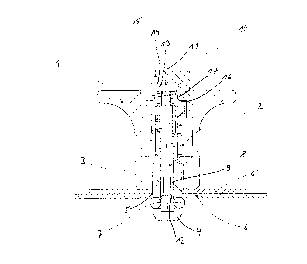Some of the information on this Web page has been provided by external sources. The Government of Canada is not responsible for the accuracy, reliability or currency of the information supplied by external sources. Users wishing to rely upon this information should consult directly with the source of the information. Content provided by external sources is not subject to official languages, privacy and accessibility requirements.
Any discrepancies in the text and image of the Claims and Abstract are due to differing posting times. Text of the Claims and Abstract are posted:
| (12) Patent Application: | (11) CA 2211202 |
|---|---|
| (54) English Title: | BALL CLAMP BOLT |
| (54) French Title: | BOULON DE SERRAGE A BILLES |
| Status: | Deemed Abandoned and Beyond the Period of Reinstatement - Pending Response to Notice of Disregarded Communication |
| (51) International Patent Classification (IPC): |
|
|---|---|
| (72) Inventors : |
|
| (73) Owners : |
|
| (71) Applicants : |
|
| (74) Agent: | KIRBY EADES GALE BAKER |
| (74) Associate agent: | |
| (45) Issued: | |
| (22) Filed Date: | 1997-07-21 |
| (41) Open to Public Inspection: | 1998-04-23 |
| Availability of licence: | N/A |
| Dedicated to the Public: | N/A |
| (25) Language of filing: | English |
| Patent Cooperation Treaty (PCT): | No |
|---|
| (30) Application Priority Data: | ||||||
|---|---|---|---|---|---|---|
|
Abstract
The invention refers to a ball clamp bolt used to provide
a detachable connection between two plates each of which has a
hole. The ball clamp bolt has a grip, a positioning bolt
which can be shifted relatively to the grip against the force
of a first spring, this positioning bolt having a locking
piece at its free end. The locking piece can be adjusted by
means of a plunger which can be shifted relatively to the
positioning bolt from a locking position preventing the
passage of the positioning bolt through the holes to a release
position extending into a recess in the plunger and permitting
such passage. Between the plunger and the positioning bolt
there is a second spring. The recess has on the side facing
the locking piece a sidewall inclined to the axis of the
plunger on which the locking piece can slide into the recess.
Cette invention concerne un boulon de serrage à billes servant à établir une connexion détachable entre deux plaques percées toutes deux d'un trou. Ce boulon de serrage à billes comporte une poignée et un boulon de positionnement susceptible de se déplacer par rapport à la poignée en agissant contre un premier ressort, ce boulon de positionnement étant muni d'une pièce de verrouillage sur son extrémité libre. On peut ajuster la pièce de verrouillage au moyen d'un manche mobile pouvant être déplacé par rapport au boulon de positionnement en le faisant passer d'une position de verrouillage, où le boulon de positionnement n'est pas en mesure de traverser les trous, à une position de desserrage où, en se retirant dans un enfoncement du manche, cette pièce laisse alors au boulon de positionnement la liberté de les traverser. Un deuxième ressort est placé entre le manche et le boulon de positionnement. Du côté de la pièce de verrouillage, le renfoncement présente une paroi latérale orientée suivant l'axe du manche, sur lequel la pièce de verrouillage peut glisser pour entrer dans le renfoncement.
Note: Claims are shown in the official language in which they were submitted.
Note: Descriptions are shown in the official language in which they were submitted.

2024-08-01:As part of the Next Generation Patents (NGP) transition, the Canadian Patents Database (CPD) now contains a more detailed Event History, which replicates the Event Log of our new back-office solution.
Please note that "Inactive:" events refers to events no longer in use in our new back-office solution.
For a clearer understanding of the status of the application/patent presented on this page, the site Disclaimer , as well as the definitions for Patent , Event History , Maintenance Fee and Payment History should be consulted.
| Description | Date |
|---|---|
| Inactive: IPC from MCD | 2006-03-12 |
| Time Limit for Reversal Expired | 2003-07-21 |
| Application Not Reinstated by Deadline | 2003-07-21 |
| Inactive: Abandon-RFE+Late fee unpaid-Correspondence sent | 2002-07-22 |
| Deemed Abandoned - Failure to Respond to Maintenance Fee Notice | 2002-07-22 |
| Application Published (Open to Public Inspection) | 1998-04-23 |
| Inactive: IPC assigned | 1997-10-21 |
| Classification Modified | 1997-10-21 |
| Inactive: IPC assigned | 1997-10-21 |
| Inactive: First IPC assigned | 1997-10-21 |
| Application Received - Regular National | 1997-10-01 |
| Filing Requirements Determined Compliant | 1997-10-01 |
| Letter Sent | 1997-10-01 |
| Inactive: Filing certificate - No RFE (English) | 1997-10-01 |
| Abandonment Date | Reason | Reinstatement Date |
|---|---|---|
| 2002-07-22 |
The last payment was received on 2001-06-13
Note : If the full payment has not been received on or before the date indicated, a further fee may be required which may be one of the following
Please refer to the CIPO Patent Fees web page to see all current fee amounts.
| Fee Type | Anniversary Year | Due Date | Paid Date |
|---|---|---|---|
| Application fee - standard | 1997-07-21 | ||
| Registration of a document | 1997-07-21 | ||
| MF (application, 2nd anniv.) - standard | 02 | 1999-07-21 | 1999-04-22 |
| MF (application, 3rd anniv.) - standard | 03 | 2000-07-21 | 2000-05-08 |
| MF (application, 4th anniv.) - standard | 04 | 2001-07-23 | 2001-06-13 |
Note: Records showing the ownership history in alphabetical order.
| Current Owners on Record |
|---|
| ERWIN HALDER KG |
| Past Owners on Record |
|---|
| DIETER HUMMEL |
| WERNER HALDER |